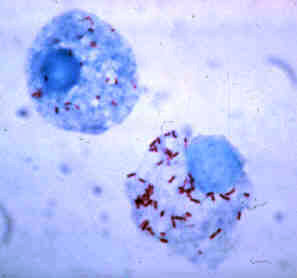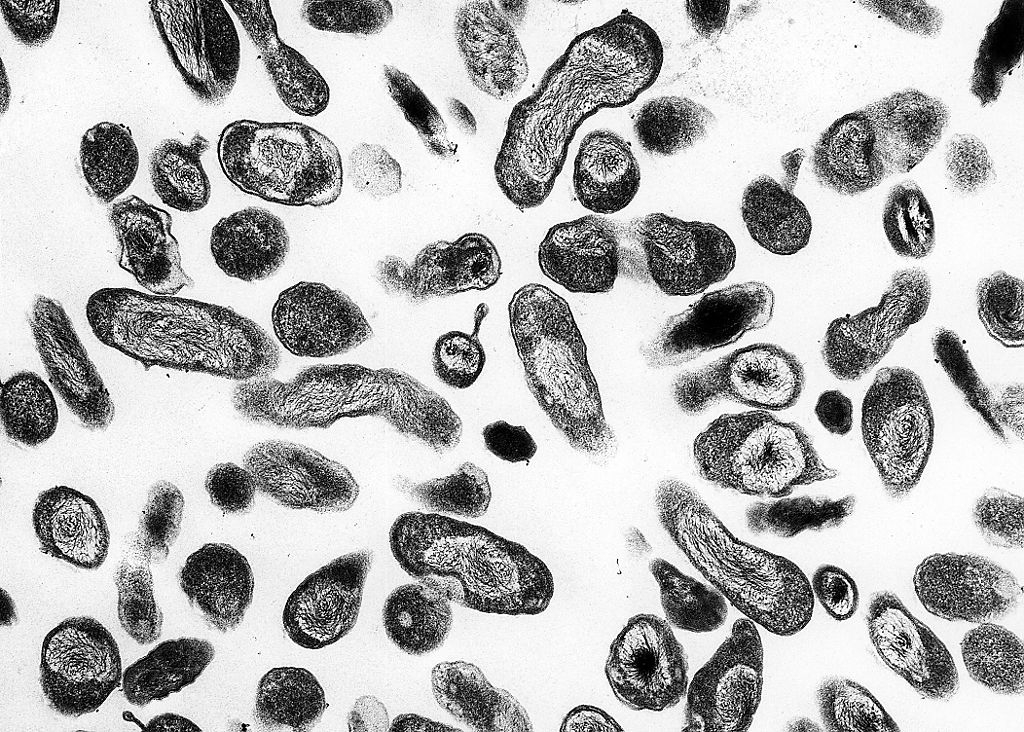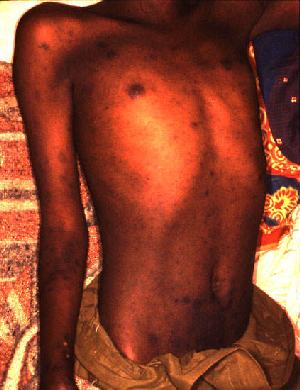Playlist
Show Playlist
Hide Playlist
Rickettsia
00:01 Rickettsia, a bacteria. 00:03 The Rickettsia are small gram negative nonmotile pleomorphic organisms. 00:10 In fact, they've been labelled sometimes as being obligate intracellular parasites, however, if you look on the image on the slide, you can see in a gram negative appearance these small organisms which appear to be coating the outside of cells - in fact, they are living internally but they appear very prominent on this particular stained slide. 00:30 in fact, they are living internally but they disappear very prominent on this particular stained slide. 00:34 Most Rickettsia, in fact, all Rickettsia have some association with a zoonotic disease meaning that they are transmitted from some animal source or some vector source which is outside of the human being. 00:47 In terms of pathogenesis, the Rickettsia start by binding to a endothelial cell, so a small cell lining a small blood vessel and within that cell, they create and have a slow replicative process, they grow very slowly. 01:04 Eventually, though, they're able to spread as they shed from the infected cells having released themselves through cell lysis. 01:11 It is the lysis of those cells, the rupture of the cells which finally exposes the Rickettsia to the human immune system and its recognition and it is then able to start a systemic response. 01:25 This continues to be a recurring theme. 01:27 Intracellular pathogens create a clinical response only when they rupture their host. 01:33 They're able to grow silently and productively within the host cell prior to doing that. 01:40 If we look at the Rickettsia and related diseases, we can look at a typical incubation period which accounts for most of these infections, and this is a relatively small window of seven to twenty days, however, as always there are exceptions and we'll talk about those in just a bit. 02:00 Chronic Q fever coming from Coxiella, has a prolonged incubation of months or even up to years. 02:08 The clinical features in general and this is a gross generalization, are an abrupt onset of flu like illness, fevers with rigors, headaches - severe headaches, and myalgias; many times followed by or at least associated with a rash. 02:25 The exception in this case would be endemic typhus and chronic Q fever which may have a much more gradual onset to what I usually expect to see. 02:36 Geographic distribution in the United States. 02:40 Rocky Mountain spotted fever is the sort of signature Rickettsial infection that we discussed and although it says that it's limited to the Southeastern and Southcentral States, in fact, cases had been reported in many parts of the country most recently in the Southwestern part of the country, whereas endemic typhus, another type of Rickettsial type disease is found in the southeastern states, in a much more humid environment. 03:07 Reservoirs for many of these Rickettsial pathogens are rodents, our small lovely little rodent friends and the vector, the way that the infection is transmitted from rodent to humans is typically through a rat bites or through the bites of fleas, flies, ticks and other biting things. 03:28 So, as a general rule, the Rickettsial pathogens and related diseases which we'll talk about in this presentation live in an animal source, a zoonotic source and then are transmitted from that source to the human beings by some sort of vector, some sort of biting insect. 03:47 The treatment for almost all of these is a tetracycline such as doxycycline or chloramphenicol in those parts of the world which still have access to that antibiotic. 03:59 Looking now specifically at some of these diseases and we start again with the signature one, Rocky Mountain spotted fever caused by a Rickettsia rickettsii. 04:10 The vector for this is the tick although there are several different forms of ticks depending on what part of the country or even part of the world the disease is transmitted. 04:21 Typical Rocky Mountain spotted fever has abrupt onset of the usual symptoms and the usual symptoms that I noted before are flu-like, high fever, rigors, severe headaches, and myalgias. 04:36 In fact the classic triad is as you see there, headache and fever followed then by a characteristic rash. 04:42 The rash is most often a macular rash, so flat patches which are erythematous in nature but rapidly become petechial in nature so they are dark purple spots. 04:54 It starts peripherally in fact classically starting at the wrists and the ankles, and it moves centrally coming to the trunk, the palms and the soles. 05:04 What's that? Palms and soles, that should strike a memory if you've previously studied the talk on syphilis. 05:13 Syphilis, secondary syphilis, is another entity that also causes a palmar and plantar rash. 05:20 Rocky Mountain spotted fever with Rickettsia, is another principal one, remember that. 05:27 Ticks are the primary reservoir and transmission vector for rickettsia rickettsia. 05:31 The hardbody tick or Ixodes tick is the primary carrier in the United States on the East Coast. While wood ticks such as you see on the slide in the picture on the left, are often the vector in more Western states. 05:44 The bacteria itself is an obligate intracellular pathogen that primarily infects vascular endothelial cells. 05:51 The invasion of those endothelial cells leads to vasculitis, such as you see on the photo slide on the right, and that ultimately produces the characteristic particular skin finding that is so classic for Rocky Mountain Spotted Fever. 06:05 For those preparing for an exam, a frequent test question is that the particular rash can appear trunk limbs and various specially peripherally. 06:14 So palms and soles, wrists and ankles, which is usually not a typical sight for other causes of particular rash. 06:23 Epidemic Typhus, perhaps the next most common caused by Rickettsia prowazekii and this is transmitted through the bite of a louse, so those who were infected with lice are at risk of this particular process. 06:36 And as an epidemic, it can occur in clusters or individually throughout the world. 06:41 Patients with epidemic typhus have the abrupt onset of symptoms as discussed but in addition, they'll typically have polyarthralgias, and they may be migratory so starting with the wrist and then the knee and then an elbow, etc. and so forth. 06:57 Patients with epidemic typhus, in contrast to Rocky Mountain spotted fever, have an outward spreading macular rash, so starting central and then moving peripherally. 07:08 Endemic or murine typhus, caused by a different Rickettsial pathogen, this one being Rickettsia typhi, the vector here are fleas, so not lice but fleas, biting fleas, and this one is somewhat different as noted before in having a gradual onset of the flu-like illnesses but also it is still associated with a maculopapular rash. 07:32 However, this one while starting centrally, does not go to include the palms or soles, so absence of palmar and plantar rash, in this case, should suggest endemic or murine typhus. 07:46 Rickettsialpox, caused by Rickettsia akari is transmitted by mites, again, abrupt onset of the typical flu-like illness, it generalize papulovesicular rash which is accompanied by sloughing. 07:59 So papules meaning like raised dots but a vesicular component meaning that there's a small purulent material, almost like a pox such as you might see with chicken pox - multiple of these lesions starting centrally and perhaps even including the peripheral extremities, is consistent with Rickettsialpox but the progression of the rash is important. 08:23 These lesions rapidly progress to slough or lose the surface layer of the rash. 08:29 Q fever caused by Coxiella burnetii. 08:33 This is the one we talked about that in chronic form is somewhat different from the rest of the diseases we are talking about. 08:40 However, in acute form, it starts abruptly as we've talked about fever, chills, polymyalgias - and many times will go on to involve the liver with a granulomatous hepatitis process. 08:53 So some patients may come to you with fevers and hepatitis and no known exposure - because there's no known vector transmission, and the answer here would be Q fever. 09:06 Importantly, they have no rash. 09:08 The chronic form of Q fever is many times found to be a fever of unknown origin because that may be the only symptom that the patient describes. 09:20 Ehrlichiosis caused by several different Ehrlichia species is another of the tick associated diseases typically found in the states typically found in the Midwestern part of the States but also going to the Rocky Mountains. 09:35 Patients with Ehrlichiosis will have abrupt onset of the flu-like illness along with, even more severe systemic manifestations including anorexia, nausea and some vomiting. 09:47 Many times if untreated, they'll go on to include a macular rash which typically starts all over all the same time. 09:56 Distinction: Rocky Mountain spotted fever, the other tick associated disease we've just talked about start peripherally, wrists and ankles and moves centrally. 10:06 Ehrlichiosis, which we're talking about right now, starts all over and is typically not petechial but much more a macular, a flat red macular rash. 10:18 And these patients will go on to develop multi organ involvement including hepatitis. 10:23 On diagnosis, and this is something the laboratory can look for specifically. 10:27 They can look by Wright stain on the blood smear at the monocytes and they'll find mulberry-like inclusions and that is almost pathognomonic for an Ehrlichia infection. 10:39 Alicea Chafe Genesis or Ehrlichiosis, is transmitted to humans by the Lone Star tick, as you see in this picture on the left. 10:48 It's a species common to the southeastern part of the United States. 10:51 White tailed deer serve as the natural reservoir for this bacteria. 10:55 And the bottom right, you see a peripheral blood smear after a right stain. 10:59 And it demonstrates a classic mulberry like cluster of bacteria called an intra monocyte marula. 11:06 Presence of this marula is diagnostic for ehrlichiosis. 11:10 Cat-scratch fever. Yeah, cats are very adorable but they do tend to scratch while playing and if the cats themselves have Bartonella in their blood stream and if they also have an infestation with fleas or lice, and if, while scratching themselves they scratch the flea or lice body and get their own blood on their claws and if they then scratch their loving owner who is just trying simply to feed them or pet them, or something like that, then they can inoculate the human being with Bartonella species and especially the organism called Bartonella henselae. 11:49 Patients who acquire Bartonella infection in this mechanism, would develop an initial papule or pustule at the site of the scratch. 11:58 Rarely, a bite if the cat is one of those cats and then the human beings develop a chronic development of a regional lymph node swelling in the site which drains the bite site. 12:12 Typically it's on the hand, it's on the fingers and so the chronic swollen lymph node or lymphadenopathy it's in the axilla or maybe up in the neck region. 12:23 So there are several causes of chronic lymphadenopathy bartonella or cat scratch disease, cat scratch fever, is one of them. 12:32 Here is out last slide. We have two pictures of Rickettsial type rashes. 12:37 Both of this show a different part of the body, a flat, macular rash which may be in some part purpuric or petechial. 12:47 The appearance of those rash by itself, as you see on the slide in front of you, is not going to help you diagnose which type of Rickettsial disease or related disease the patient may have, but the progression of the rash, where it started, what it's doing, and how it is fading will help you very much. 13:05 So this is kind of a hodgepodge category of many vector associated nosocomial type of infections but remember that anything which bites as an insect typically may have acquired some infectious process from another reservoir such as a rodent or some of our family pet friends and transmitted that to you. 13:26 Beware of the innocent bite of the biting fly, tick, flea, or louse.
About the Lecture
The lecture Rickettsia by Sean Elliott, MD is from the course Bacteria.
Included Quiz Questions
Which of the following represents the classic triad of symptoms in Rocky Mountain spotted fever caused by Rickettsia rickettsii?
- Headache, fever, and inward-spreading maculopapular rash
- Headache, fever, and outward-spreading erythematous rash
- Headache, fever, and inward-spreading papular rash
- Headache, fever, and outward-spreading papular rash
- Headache, fever, and inward-spreading violaceous rash
A migratory polyarthritis and an outward-spreading macular rash can be seen in which rickettsial infection?
- Epidemic typhus
- Endemic typhus
- Q fever
- Rickettsialpox
- Rocky Mountain spotted fever
The maculopapular rash in endemic typhus caused by Rickettsia typhi is found on which part of the body?
- Trunk
- Hands
- Feet
- Back
- Face
Which type of rash is associated with rickettsialpox caused by infection with Rickettsia akari?
- Papulovesicular rash
- Macular rash
- Vesicular rash
- Maculopapular rash
- Papular rash
Granulomatous hepatitis is associated with which rickettsial disease?
- Q fever
- Ehrlichiosis
- Epidemic typhus
- Endemic typhus
- Rickettsialpox
Mulberry-like inclusions in monocytes can be found in which rickettsial infection?
- Ehrlichiosis
- Q fever
- Rocky Mountain spotted fever
- Endemic typhus
- Cat scratch fever
Customer reviews
5,0 of 5 stars
| 5 Stars |
|
5 |
| 4 Stars |
|
0 |
| 3 Stars |
|
0 |
| 2 Stars |
|
0 |
| 1 Star |
|
0 |






